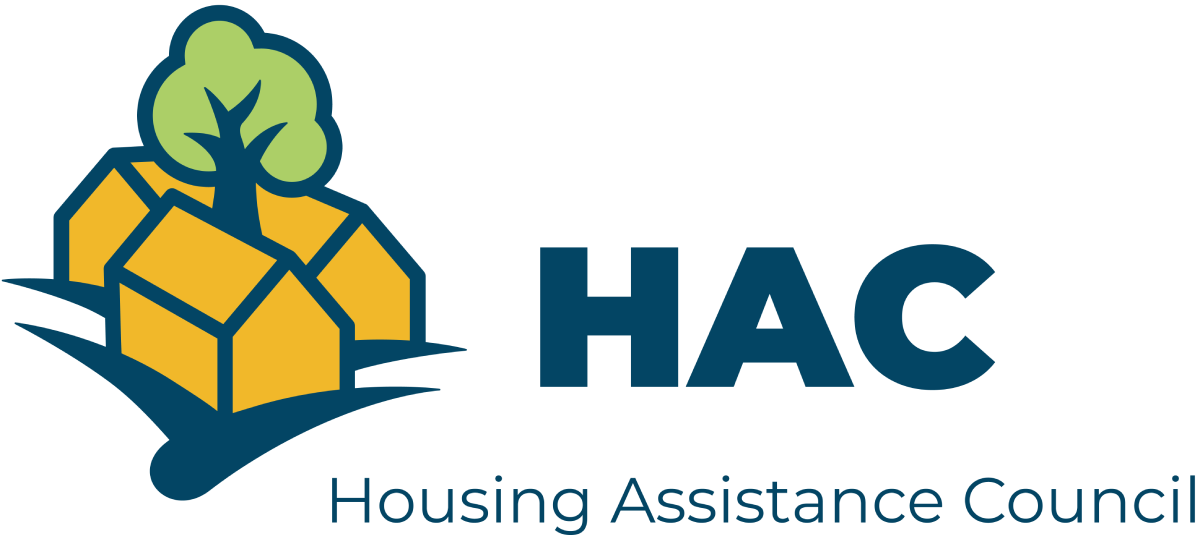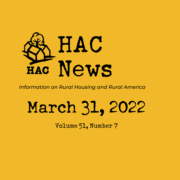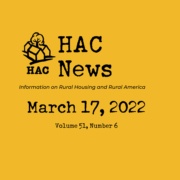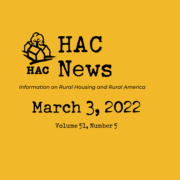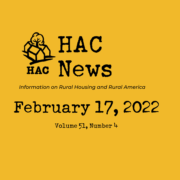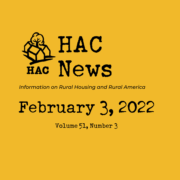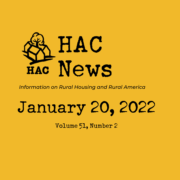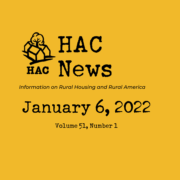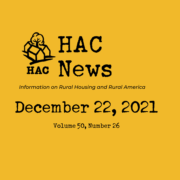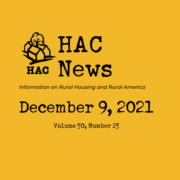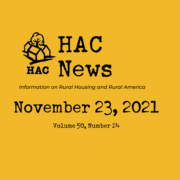HAC News: March 31, 2022
Vol. 51, No. 7
TOP STORIES
Budget proposes to increase nationwide housing production and rural rental preservation.
The Biden Administration’s budget for fiscal year 2023 proposes to boost housing production in almost every USDA rural housing program and many HUD programs.
- USDA direct lending for both homeownership and rental housing would increase, as would guaranteed loans for rental housing, home repair loans and grants, and rental preservation resources. Preservation funding through the Section 515 program would jump from $50 million in FY22 to $200 million under the budget, and the Multifamily Preservation and Revitalization program would almost double from $34 million to $75 million.
- USDA proposes a multi-pronged approach to support tenants in rental properties where USDA mortgages are ending. It would decouple Section 521 Rental Assistance from Section 515 and 514 mortgages, so that some tenants could continue to receive RA after mortgage maturity. Tenants in other properties leaving USDA’s programs would receive Tenant Protection Vouchers from HUD, while those who currently have USDA Section 542 vouchers would be eligible to renew them.
- A new Housing Supply Fund would be created at HUD to provide $25 billion in mandatory grants to states, localities, tribes, and partners for housing production, with another $10 million for removal of state and local barriers to production. Also contributing to housing supply increases would be $10 billion in the Treasury Department’s budget for additional Low Income Housing Tax Credits and a new $5 billion for CDFIs to finance production and preservation of housing, with an emphasis on underserved areas and small properties.
- HOME, CDBG, homeless assistance, Section 202 for seniors, Section 811 for persons with disabilities, and housing vouchers would also receive increases. Native American housing would see a slight drop from $1.002 billion to $1 billion, but tribes would be eligible for the new Housing Supply Fund.
- USDA, HUD, and Treasury all emphasize the importance of energy efficiency and climate resiliency.
- More details are posted on HAC’s website for USDA and HUD programs, as well as materials and a recording from HAC’s budget webinar held on March 30.
April is Fair Housing Month.
Fair housing information is available on HUD’s website.
HAC receives gift from MacKenzie Scott.
HAC is pleased to announce a $7,000,000 gift from MacKenzie Scott, the largest private gift in HAC’s 50-year history. HAC will leverage this funding to establish and grow local organizations that build affordable housing in the nation’s poorest and most rural places. This gift ensures that more people and more communities will enjoy the benefits of American prosperity.
RuralSTAT
USDA’s Section 502 direct loan program provided over 5,350 mortgages to low- and very low-income homebuyers in fiscal year 2021, and the increased funding proposed for FY23 would support around 7,800 mortgages. Source: 2023 USDA Budget Explanatory Notes – Rural Housing Service.
OPPORTUNITIES
Rural places prioritized for Youth Homelessness Demonstration Program funding.
Nonprofits, tribes or tribally designated housing entities, and state or local governments collaborating with Continuums of Care can apply by June 28 for the Youth Homelessness Demonstration Program, designed to address systemic responses to youth homelessness and significantly reduce the number of youth experiencing homelessness. HUD will select up to 25 communities, with a priority for communities with substantial rural populations in up to eight locations. For more information, contact Caroline Crouse, HUD, 612-843-6451.
Farm labor housing repair deadlines corrected.
Preapplications are due May 9 rather than April 2 for funding to repair USDA off-farm Section 514/516 farmworker housing. Funds can be used either for substantial rehabilitation or for limited improvements, repairs, or modifications such as accessibility compliance and health and safety issues. USDA will hold a workshop for potential applicants on April 13. For more information, contact Jonathan Bell, USDA, 254-742-9764.
HUD seeks nominations for tribal advisory committee.
HUD requests nominations by May 31 of elected or appointed tribal leaders to represent federally recognized tribal governments and Alaska Native Corporations on an Intergovernmental Tribal Advisory Committee. The committee will supplement, not replace, existing tribal consultation processes. For more information, contact Heidi J. Frechette, HUD, 202-401-7914.
Webinar to cover broadband for affordable rural housing.
Affordable Housing & Affordable Broadband: A Conversation with Rural LISC and CTC Energy & Technology, scheduled for April 13, will address the steps affordable housing owners, operators, lenders, and other stakeholders in rural places can take to ensure competitive, accessible broadband at their properties. This is the first in a planned series of rural housing webinars from Rural LISC.
REGULATIONS AND FEDERAL AGENCIES
Appraisal equity plan released.
The Interagency Task Force on Property Appraisal and Valuation Equity, charged with identifying ways to address racial and ethnic bias in home valuations, released its action plan on March 23. The 13 participating federal agencies, including USDA and HUD, have committed to make the appraisal industry more accountable, empower consumers, prevent algorithmic bias in home valuation, cultivate an appraiser profession that is well-trained and looks like the communities it serves, and use data and expertise to inform policy, practice, and research on appraisal bias.
Treasury publishes updates to Emergency Rental Assistance guidance, spending data, and reallocation processes.
Recently updated guidance tells the state and local entities distributing ERA funds that federal privacy laws do not permit asking applicants to provide Social Security Numbers. Reallocation of unspent ERA2 funds is covered in another guidance document and information about ERA1 reallocation is updated. Finally, Treasury reports that state and local ERA grantees have made over 4.7 million payments to households and spent or obligated approximately $30 billion of the program’s total $46 billion. Treasury expects the vast majority of the remaining funds to be deployed to households or paid to grantees by the middle of 2022.
FEMA to cover some coronavirus costs through July 1.
FEMA will continue to cover the full cost of some coronavirus-related expenditures, including the costs of non-congregate shelters, through July 1, 2022.
Comments requested on updating Davis-Bacon Act regulations.
The Department of Labor is undertaking its first comprehensive review in almost 40 years of the regulations that implement the Davis-Bacon Act and related laws, requiring employers on federally funded or assisted construction projects to pay locally prevailing wages to construction workers. Comments are due May 17. For more information, contact Amy DeBisschop, DOL, 202-693-0406.
PUBLICATIONS AND MEDIA
Alternative measurement of housing affordability identifies high cost burden rate for renters.
Cost burden is usually calculated by determining whether a household spends more than 30% of income on housing, but researchers at Harvard’s Joint Center for Housing Studies calculated housing cost burdens for renters based on residual income – the amount available for other needs after paying housing expenses. “The Rent Eats First”: Rental Housing Unaffordability in the United States, published in Housing Policy Debate, reports that in their sample nearly all households with incomes under $30,000 did not have enough residual income. They found that a combined policy that addresses both housing and transportation affordability would have the largest impact on reducing residual-income cost burdens.
Updated overviews of housing programs published.
- Advocates’ Guide 2022: A Primer on Federal Affordable Housing & Community Development Programs & Policies is produced by the National Low Income Housing Coalition to educate advocates of all kinds about the programs and policies that make housing affordable to low-income people across America.
- USDA Rural Housing Programs: An Overview, issued by the Congressional Research Service, provides a more technical review of USDA’s programs and relevant issues and trends.
Rural hospital closures disproportionately affecting minority populations.
A study by the University of North Carolina Rural Research Program found that hospital closures between 2010 and 2020 were more likely to occur in rural counties that had higher share of Black and Hispanic residents, were more urbanized, and were more likely to be located in the southern U.S. compared to previous decades. These counties were also more likely to have higher income inequality than the median rural county.
HAC
Need capital for your affordable housing project?
HAC’s loan fund provides low interest rate loans to support single- and multifamily affordable housing projects for low-income rural residents throughout the U.S. and territories. Capital is available for all types of affordable and mixed-income housing projects, including preservation, new development, farmworker, senior and veteran housing. HAC loan funds can be used for pre-development, site acquisition, site development, construction/rehabilitation and permanent financing. Contact HAC’s loan fund staff at hacloanfund@ruralhome.org, 202-842-8600.
Please note: HAC is not able to offer loans to individuals or families. Borrowers must be nonprofit or for-profit organizations or government entities (including tribes).
